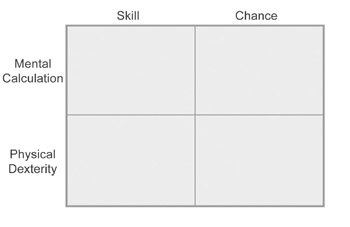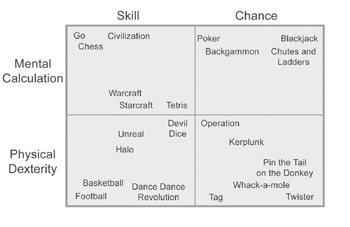The Play Matrix
|
| < Day Day Up > |
|
One valuable playtesting tool you can use is the play matrix. We developed the play matrix to help playtesters and students give context to their discussions about game systems.
The horizontal axis of the play matrix is a continuum between skill and chance. The vertical axis is a continuum between mental calculation and physical dexterity. We chose these two continua because they are core aspects of interactive experiences, and all games can be plotted along them. Think about the game of chess. It’s a game of pure strategy, a type of skill. There is absolutely no chance involved. So on the skill versus chance continuum, it would be plotted to the far left. It’s also a game of pure mental calculation. There is no physical dexterity required to play the game. So on the mental calculation versus physical dexterity continuum, it’s plotted at the very top. When chess is plotted on both these dimensions at the same time, it appears in the top left corner.

Figure 8.5: The play matrix
Now let’s think about the game of blackjack. It involves chance—but the outcome is not determined purely by chance. So it falls somewhere to the right of center on the continuum. No dexterity is required to play, so it plots at the top of the mental calculation versus physical dexterity line.
Exercise 8.6: The Play Matrix
Now it’s your turn to use the play matrix. Plot a popular videogame, such as WarCraft, Quake, or Atomic Bomberman, on the play matrix. Compare this to a game like Twister or “pin the tail on the donkey.” Now try plotting a boardgame like Monopoly, Risk, or Clue. Describe the differences and similarities between the three types of games. What does the play matrix show you?
The play matrix is not an absolute system which produces the same results every time. Different people may have different opinions on where games plot, which is okay. Everyone’s opinion has value. It’s best to use the play matrix as a tool for stimulating discussion and analyzing gameplay. The goal is to get your playtesters to think about the game and verbalize their feelings.
Figure 8.6 shows the play matrix with several games plotted in each quadrant. Can you see patterns in the types of games that fall in different quadrants? Many popular videogames fall in the lower left (physical + skill). Many popular boardgames and turn-based videogames fall in the upper left (mental + skill), many gambling games fall in the upper right (mental + chance), and many games for very young children fall in the lower right (physical + chance).

Figure 8.6: The play matrix including games
Exercise 8.7: Plotting Your Favorite Games
Take five of your favorite games and plot them on the play matrix. Describe what pattern you see. What does this tell you about yourself?
When conducting a playtesting session, it is sometimes helpful to ask your testers to plot your game on the matrix. Then follow by asking them these questions: (1) Is the outcome of the game determined more by chance or by the skills of the players? (2) Is the outcome determined more by mental skill or physical dexterity? Ask playtesters if they would move the game more towards one quadrant or another, what would they prefer? Different audiences often gravitate towards one quadrant of gameplay, even if they enjoy different genres. For example, players who enjoy strategy games from the upper left corner may also gravitate toward other mental + skill based play, such as trivia or puzzles. Young children often gravitate toward games in the lower right, focusing on physical + chance, but as they get older, they choose games requiring mental + chance.
If players are dissatisfied with your game, they may be able to verbalize it by placing games they do enjoy in other quadrants. Ask yourself what game variables you could change to move the play experience towards a quadrant with games your target audience enjoys. For example, you may want to move from the upper right (mental + chance) to upper left (mental + skill).
The solution might be to change a variable determined by chance into a variable determined by player choice. In a physical prototype this might be accomplished by removing dice from the system and replacing them with cards that a player can choose to play. In an electronic game, this might be accomplished by giving the player a choice of where to start or what weapons to use, instead of randomly generating them.
|
| < Day Day Up > |
|
EAN: 2147483647
Pages: 162